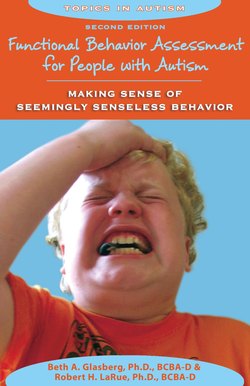Functional Behavior Assessment for People with Autism

Реклама. ООО «ЛитРес», ИНН: 7719571260.
Оглавление
Beth Glasberg. Functional Behavior Assessment for People with Autism
Table of Contents
Introduction. Is This Your Child?
Grace Carmichael
Jamaal Brown
Darra Littman
Anthony Cappozolli
1 | Why Problem Behaviors Occur
How Do We Think about Behavior Problems? A Quick History. The Punishment-Based Approach
Time-Out
Current Thinking about the Purpose of Challenging Behavior
Why Are Problematic Behaviors So Common among Individuals with ASD?
Difficulties with Communication Skills
Difficulties with Social Skills
Restricted Interests
2 | How Are Behaviors Learned?
Overview of Learning Theory
1) Consequences
Keep It Simple Summary
2) Motivation
Keep It Simple Summary
3) Antecedents
Keep It Simple Summary
4) Behavior
Keep It Simple Summary
Putting the Four Learning Variables Together
Learning Theory and Problem Behaviors: The Functions of Behavior
1) Attention
2) Objects and Activities
3) Escape/Avoid
4) Automatic Reinforcement
5) Behaviors That Serve More Than One Function
How Does My Child Choose a Behavior to Use?
3 | Getting Started: First Steps for Completing a Functional Behavior Assessment
Step 1: Create an Assessment Team
Family Members
Professionals
Peers
The Person with Challenging Behavior
Assigning Roles to Team Members
Keep It Simple Summary
Step Two: Select a Target Behavior
Guideline 1: Address Only One Behavior at a Time
Guideline 2: Habilitation
Guideline 3: Be Safe
Guideline 4: Set the Child and the Assessment Team Up for Success
Guideline 5: Consider the Needs of Significant Others
Practice Examples
Keep It Simple Summary
Step 3: Define the Target Behavior
Keep It Simple Summary
4 | Measuring Behavior
Step 4: Measure the Target Behavior
Frequency Recording
Keep It Simple Strategies
Time-Based Measures of Behavior
Keep It Simple Strategies
Intensity
Keep It Simple Summary
Using Samples of Behavior
Step 5: Establish a Baseline
Keep It Simple Strategies
5 | Finding Out Who Knows What
Step 6: Interview Team Members
Functional Behavior Assessment Interview Form
Functional Behavior Assessment Interview Form. INTERPRETATION GUIDE
SAMPLEFunctional Behavior Assessment Interview for Students
6 | Observation Time
Step 7: Observe the Behavior
Unstructured Observation
Structured Observation
7 | Test Your Hypothesis
Prior to Starting Hypothesis Testing
Antecedent Manipulations
Functional Analysis
Functional Analysis Conditions
Using Cues to Signal Conditions
Taking Safety Precautions
Analyzing Your Data
Why Is Functional Analysis Worthwhile?
Brief Models of Functional Analysis
Conclusion
8 | Alternative Assessment Models
Alternative Assessment Models
Trial-Based Functional Analyses (TBFA)
Latency-Based Functional Analyses (LBFA)
Precursor Functional Analyses
Functional Analysis of Requesting
Summary
9 | Putting It All Together A Summary of the Assessment Process
Functional Behavior Assessment Summary Form
10 | You Finally Know the Function of the Behavior Now What?
What Are the Components of an Intervention Plan?
Change the MO
Change the Antecedents
Change the Behavior
Change the Consequences
Choosing Strategies to Match the Function of the Behavior
For Attention-Maintained Behaviors
For Escape-Maintained Behaviors
For Behaviors Maintained by Access to Objects and Activities
For Behaviors Maintained by Automatic Reinforcement
11 | Special Circumstances and Troubleshooting
Adolescents and Adults
Safety Issues
Allowing Enough Time to Learn a New Behavior
Choosing the Right Setting for an Assessment
Rare, but Dangerous, Behaviors
Troubleshooting
When Assessment Results Are Inconsistent
When an Intervention Doesn’t Work
Success Stories. Aaron
Sophie
Ramone
References
Appendices
Appendix A Frequency Recording Data Sheet
Appendix B Duration of Behavior Data Sheet
Appendix C Latency to Behavior Data Sheet
Appendix D Data Sheet for Measuring the Intensity of Behavior
Appendix E Time Sample Data Sheet
Appendix F Permanent Products Data Sheet
Appendix G A-B-C Data Sheet
Appendix H Descriptive Analysis Data Sheet
Appendix I Consent Form
OVERVIEW OF FUNCTIONAL ASSESSMENT PROCEDURES
Appendix J AB Functional Analysis Data Sheet
Appendix K Antecedent Manipulation Data Sheet
Appendix L Functional Analysis Data Sheet
Index
About the Authors
Отрывок из книги
Sandra L. Harris, Ph.D., series editor
Woodbine House
.....
A general introduction to the principles of behavior will be provided in Chapters 1 and 2, including a discussion of how challenging behaviors arise and why individuals with autism spectrum disorders are more susceptible to developing them. Other foundation topics covered in these chapters will include an introduction to the principles of learning, a discussion of factors determining which behaviors will be performed in a given situation, and an overview of the types of consequences that may strengthen behaviors. Furthermore, Chapters 1 and 2 include an overview of functional behavior assessment and a discussion of how functional behavior assessment helps make sense of otherwise perplexing behaviors.
This background will equip readers for Chapters 3 through 8, which offer a practical, step-by-step guide to completing a functional assessment, including various forms of functional analysis—the “gold standard” in identifying the reasons why a behavior is occurring and informing effective intervention. These chapters also include “Keep it Simple Tips” to make the process more manageable, and handy tools to use when completing an assessment. This guide will help readers learn how to interpret assessment results, which are ultimately needed to develop an effective intervention. Chapter 9 summarizes the process, while Chapter 10 provides an overview of how to turn these assessment results into an effective plan. Finally, Chapter 11 addresses special topics such as adult issues, very infrequent but severe behaviors, and troubleshooting.
.....